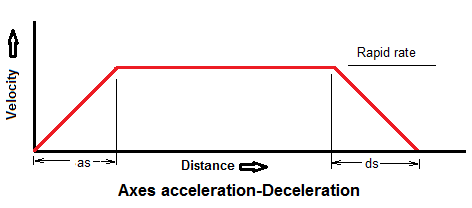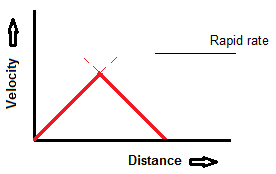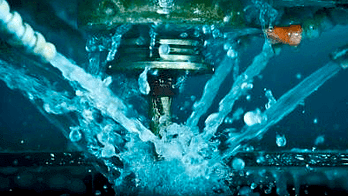CNC acceleration and deceleration – how axes actually move

CNC acceleration and deceleration: When you command an axis to move at rapid traverse, it does not instantly start off at 20 m/min or whatever the machine’s rapid rate is (in fact, nothing on earth can start off instantly like this, including the cheetah in the picture). The axis accelerates to the rapid rate gradually, and when it nears the destination, it decelerates to zero velocity gradually, like the graph shows.

Acceleration/deceleration is measured in g, the good old acceleration due to gravity that we all learnt about in school. 1g is 9.8 m/sec2. The typical CNC lathe or machining center has an acceleration of 0.2g (2 m/sec2). High speed machines have accelerations up to 2g (20 m/sec2). These equations (familiar to anyone who has done any course related to mechanical engineering) enable you to calculate the acceleration time and distance.

If the machine has a rapid rate of 20 m/min and 0.2g acceleration, the time and distance to accelerate to rapid are 0.17 secs. and 28 mm. respectively. The time to move a certain distance is never the distance divided by the rapid rate. When we estimate the cycle time, we usually ignore the time for rapid motions, but in small parts it can make a big difference. Example On a 0.2g, 20 m/min machine, if you drill these holes to a depth of 10 mm at a feedrate of 500 mm/min, the cutting time is 18 secs. and the rapid traverse time is 5.5 secs, almost 25 % of the total time. With a 1g, 60 m/min machine, the rapid traverse time drops to 2.1 secs.


Action point
When calculating the cycle time for small parts, consider this factor. Or you could just save the headaches of doing this by using CADEM CAPSturn CNC lathe programming software and CAPSmill CNC milling programming software, that automatically consider the acceleration/deceleration when calculating cycle time.

Transform production and profits dramatically, in just a few months.
With a CNC machine monitoring system.
Etc
Coffee and Chicory gyan
For a while now I’ve been buying my coffee at a shop near my house that is more like a ‘coffee classroom’ for me. Each time I go there to buy coffee, I get to chat with the owner and he educates me about new facets of the brew. The owner has a coffee export business, and the shop is actually his office. His work mostly is through emails on his laptop, and the shop gives him a welcome periodic break from his paperwork, as people come to buy the coffee.

He has a roasting-cum-grinding machine, and mixes the beans (your preferred percentage of Arabica + Robusta + chicory) right in front of you. After he chucks in my blend (which is zero chicory), asks me whether I have an electric machine or the old-stype coffee filter, sets the grain size and starts the machine, we chat while the roasting and grinding is going on. There’s a delightful aroma of roasting coffee while we’re doing this.

An interesting thing I learnt is the role of Chicory in coffee. Coffee is drunk in the south of India (the other parts being Tea addicts), and among coffee addicts you have two die-hard camps: the ‘Pure coffee, no chicory’ people and the ‘Pure coffee tastes foul, it MUST have chicory’ people.

According to my coffee guru, chicory has a faintly similar taste to coffee, and makes the coffee taste thicker. It has no caffeine. It is the powered form of the root of the chicory plant, and costs half to one-third the price of coffee. To reduce costs, the coffee in instant coffee and in coffee shops can have upto 50 % chicory. Its use in fact started in France in the 1800s, when there was a major coffee shortage. It was used to reduce the cost of each cup of coffee, and sometimes even replaced the coffee, depending on the person’s bank balance.


